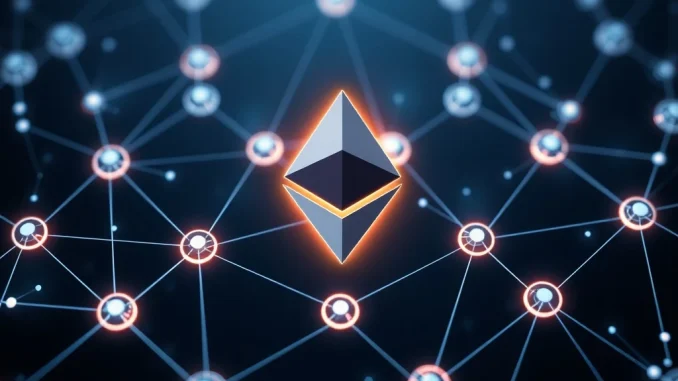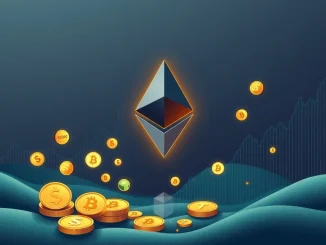
In the dynamic world of digital assets, significant moves by key players often send ripples across the entire ecosystem. The latest buzz in the Ethereum staking landscape revolves around Blockscape, a prominent validator, which has just made a substantial increase to its Ethereum (ETH) holdings. This strategic expansion is not just about accumulating more ETH; it’s a calculated step that positions Blockscape among the elite, enhancing its influence and contributing significantly to the network’s security and operational stability.
Blockscape’s Bold Move: Elevating Among Elite ETH Validators
Blockscape has dramatically bolstered its presence in the Ethereum network by adding a hefty 140 ETH to its existing stake. This brings their total staked ETH to an impressive 627 ETH, valued at approximately $510,000 USD. This move is more than just an investment; it’s a declaration of commitment, propelling Blockscape into the ranks of the top 50 ETH validators globally by stake size. This achievement, reported on July 27, 2025, underscores the validator’s growing influence within Ethereum’s robust Proof-of-Stake (PoS) ecosystem.
But what does it mean to be a top validator? In Ethereum’s PoS model, validators are crucial. They are responsible for proposing and validating new blocks, storing data, and maintaining the network’s integrity. The more ETH a validator stakes, the higher their chances of being selected to propose blocks and earn rewards. Blockscape’s increased stake directly correlates with an enhanced likelihood of:
- More Frequent Block Proposals: Leading to increased staking rewards.
- Greater Influence in Consensus: Playing a larger role in confirming transactions and securing the chain.
- Strengthened Network Participation: Contributing more significantly to Ethereum’s decentralization efforts.
This strategic accumulation is a common tactic among validators aiming to maximize returns and solidify their position in competitive PoS environments. It reflects a tangible commitment to Ethereum’s long-term vision and security.
Understanding the Power of Proof-of-Stake
Ethereum’s transition from Proof-of-Work (PoW) to Proof-of-Stake with ‘The Merge’ marked a pivotal moment for the blockchain. Unlike PoW, which relies on energy-intensive mining, PoS secures the network by requiring validators to ‘stake’ (lock up) their ETH. This mechanism offers several advantages:
- Energy Efficiency: Significantly reduces the energy consumption of the network.
- Enhanced Security: Makes 51% attacks prohibitively expensive and easier to detect.
- Scalability Potential: Paves the way for future upgrades like sharding.
- Decentralization: Encourages broader participation from ETH holders.
Blockscape’s expanded stake directly contributes to these PoS benefits. By increasing their stake, they enhance their capacity to resist malicious attacks. An attacker would need to compromise a significant portion of the total staked ETH to execute a 51% attack, making the network incredibly resilient. This aligns perfectly with Ethereum’s design philosophy, where higher validator diversity and substantial individual stake sizes collectively reinforce the network’s strength and stability.
Regulatory Clarity: Fueling Ethereum Staking Growth
A significant factor contributing to Blockscape’s strategic expansion, and indeed the broader growth in Ethereum staking, has been the evolving regulatory landscape. The U.S. Securities and Exchange Commission (SEC) has provided crucial clarity regarding staking rewards. The SEC clarified that staking rewards derived from direct participation in Ethereum’s PoS network are not classified as investment returns under securities laws. This regulatory certainty is a game-changer.
Why is this important?
- Reduced Legal Uncertainties: Validators like Blockscape can operate with greater confidence, free from the specter of being classified as unregistered securities.
- Encourages Institutional Participation: Provides a clearer pathway for larger entities and traditional financial institutions to engage in staking.
- Fosters Innovation: Creates a more predictable environment for developing staking-as-a-service platforms and related financial products.
This clarity effectively reduces legal risks for participants, encouraging further stake accumulation and solidifying Ethereum’s position as a robust and legally defined asset for staking activities.
What Does This Mean for the Crypto News Landscape?
Blockscape’s move is more than just an isolated event; it’s a strong indicator of maturing trends within the broader cryptocurrency market, particularly in the staking sector. As mid-sized validators like Blockscape grow their stakes, the competition for staking rewards is likely to intensify. This could potentially alter the distribution of earnings across the network, leading to a more dynamic and competitive environment for staking yields.
Financial analysts are closely watching these developments. Shifts in reward dynamics are anticipated as entities scale their participation, which could influence investment strategies for both individual stakers and institutional players. While the immediate impact on other cryptocurrencies might not be directly evident from this single event, the overarching trend of professionalizing and scaling staking operations is a significant piece of crypto news that reflects increasing institutional confidence in the underlying technology and regulatory environment.
The broader Ethereum staking landscape is undeniably evolving, with validators increasingly prioritizing strategic stake accumulation to secure competitive advantages. This signals a shift towards a more sophisticated and capital-intensive staking ecosystem.
Blockscape’s Impact on Network Security and Decentralization
Beyond the financial incentives, Blockscape’s increased stake plays a vital role in enhancing Ethereum’s network security. A larger, more distributed set of substantial validators makes the network more resilient against potential attacks. For a 51% attack to be successful, an attacker would need to control over half of the total staked ETH, a feat that becomes exponentially harder as individual stakes grow and are managed by diverse entities.
Blockscape’s alignment with regulatory clarity and competitive dynamics highlights the maturing nature of Ethereum’s staking environment. As more validators adopt similar strategies, the network’s security and decentralization could see further reinforcement. However, it’s crucial that stake distribution remains balanced to prevent over-centralization. The current trend suggests a healthy competition that, if maintained, will only strengthen Ethereum’s foundational security and resilience.
Blockscape’s recent expansion of its Ethereum stake is a powerful testament to the growing confidence in Ethereum’s Proof-of-Stake model and the clarity provided by regulatory bodies. By entering the top 50 ETH validators, Blockscape not only secures enhanced staking rewards but also significantly contributes to the network’s security, stability, and decentralization. This move reflects a broader trend of strategic accumulation and professionalization within the Ethereum staking ecosystem, promising a more robust and resilient future for one of the world’s leading blockchains.
Frequently Asked Questions (FAQs)
Q1: What is Ethereum staking?
Ethereum staking is the process of locking up a certain amount of ETH (currently 32 ETH for a solo validator) to participate in the network’s Proof-of-Stake consensus mechanism. By staking, individuals or entities become ‘validators’ and help secure the network by processing transactions and creating new blocks, for which they earn rewards.
Q2: How does Blockscape’s increased stake benefit Ethereum’s network security?
Blockscape’s larger stake enhances network security by making it more difficult and expensive for malicious actors to launch a 51% attack. A greater amount of staked ETH distributed among many active validators increases the overall cost and complexity of compromising the network, thus strengthening its resilience.
Q3: What role did regulatory clarity play in Blockscape’s decision?
The U.S. SEC’s clarification that staking rewards from direct participation in Ethereum’s PoS network are not classified as investment returns under securities laws significantly reduced legal uncertainties. This regulatory clarity provides a more secure operational environment, encouraging validators like Blockscape to increase their stakes without fear of unforeseen legal risks.
Q4: How does Blockscape’s move impact other Ethereum validators?
As mid-sized validators like Blockscape increase their stakes, it intensifies competition for staking rewards across the network. This can lead to shifts in reward dynamics and potentially encourage other validators to optimize their strategies or increase their own stakes to remain competitive.
Q5: What is Proof-of-Stake (PoS) and why is it important for Ethereum?
Proof-of-Stake (PoS) is a consensus mechanism where validators are chosen to create new blocks based on the amount of cryptocurrency they ‘stake’ as collateral. For Ethereum, PoS is crucial because it significantly reduces energy consumption, improves scalability potential, and enhances network security compared to its previous Proof-of-Work (PoW) system.
Q6: Is Ethereum staking accessible to everyone?
While solo staking requires 32 ETH, which can be a significant amount, there are also liquid staking solutions and staking pools that allow individuals to stake smaller amounts of ETH. These options make Ethereum staking more accessible to a broader range of participants, enabling them to earn rewards and contribute to network security.



